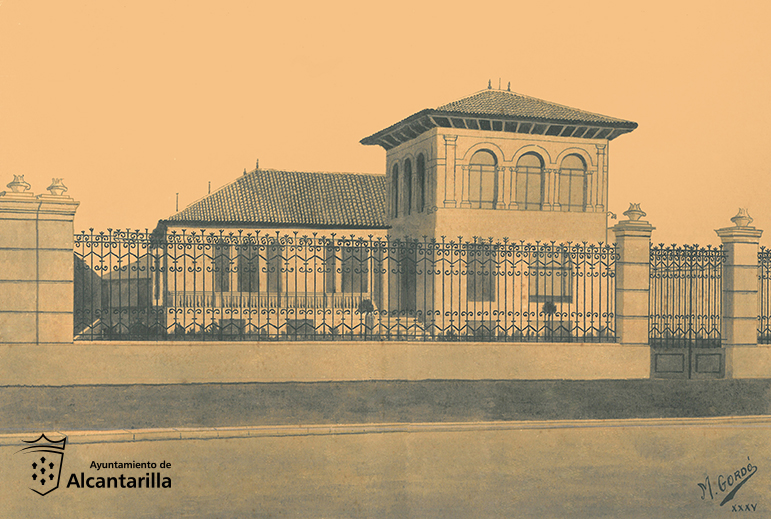
The family home of the industrialist José Pérez Almagro, known as “Chalet de Melgar”, was built at the beginning of the 1930s on the old Lorca Road, on the outskirts of the town of Alcantarilla. During the Spanish Civil War, it was occupied by the Republican side as their headquarters.
It was a single-storey building, with a semi-basement and a quadrangular-shaped, two-storey lookout tower, with three arcades on each of the upper walls and a four-slope roof with a high overhanging eave. Inside, the main entrance hall, with a wooden coffered ceiling, led to the noble staircase that led to the living room on the upper floor, which was lit by twelve large windows. The chalet was surrounded by a large, covered garden, which occupied a large area between the Calle Mayor, from which the house was accessed, and Calle Sagunto. Its formal characteristics place this construction in relation to other villas of the period, such as those that still exist next to the Malecón in Murcia or those built by the bourgeoisie of commerce and industry in the capital, in the vicinity of the Mar Menor.
To the right of the house there was an interior street which, as a service road, provided access for workers and lorries to the factory at the rear. The fact that the businessman’s residence and the factory shared the same space made the complex a clear example of industrial architecture from the beginning of the last century.
José Pérez Almagro, a native of Javalí Nuevo, was an important industrialist, known as “Melgar”, and a councillor on the Murcia City Council in 1928. In the 1930s, he ran a canning factory in Javalí Nuevo. Taking advantage of the possibilities offered by the proximity of the railway, he decided to settle in Alcantarilla, where he set up a wood factory and his private home. The proximity to Lorca Station allowed him to have his own railway line, where the wagons came in to load and unload the wood logs coming from the Sierra de Segura, as it happened in the other sawmills installed in Alcantarilla since the end of the 19th century, with José Precioso.
The arrival of the railway to Alcantarilla led to a notable economic development of the industrial timber and canning sector in the town from the first decades of the 20th century, generating jobs, population growth and the consequent urban expansion, in which the houses of industrialists built in the Calle Mayor or, as in this case, on the outskirts, close to the railway line, would stand out as a symbol of the power of their owners, which offered so many advantages to the timber factories.
The “chalet de Melgar”, a symbol of the boom reached by the timber industry in the first decades of the 20th century, gradually became integrated into the buildings on the old Calvo Sotelo avenue, when the Campoamor neighborhood was urbanised and widened. The house, half-hidden behind the pines and palm trees in the large garden, continued to give the street a unique charm.
The old Lorca Road gradually changed its appearance with the modern buildings which, little by little, formed the second phase of Alcantarilla’s main thoroughfare, known as Calle Mayor since 1980. In the 1990s, the “chalet de Melgar” was demolished and its site was used for the construction of six-storey blocks, in accordance with the General Urban Development Plan, approved in 1984.
Two palm trees from the old garden are still standing today. Part of the fence that surrounded the chalet was placed in the chapel of the Holy Sepulchre of the parish church of San Pedro Apóstol.

